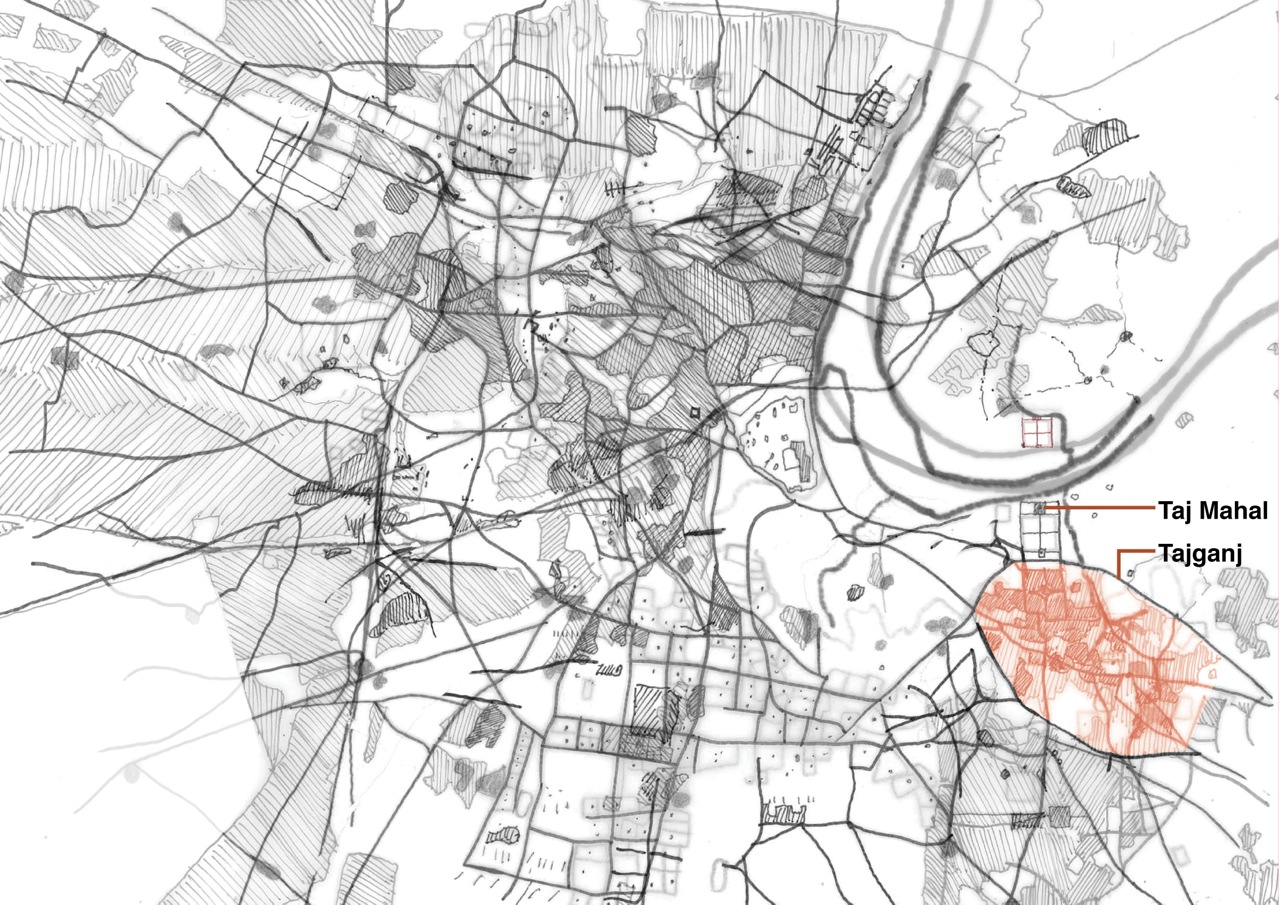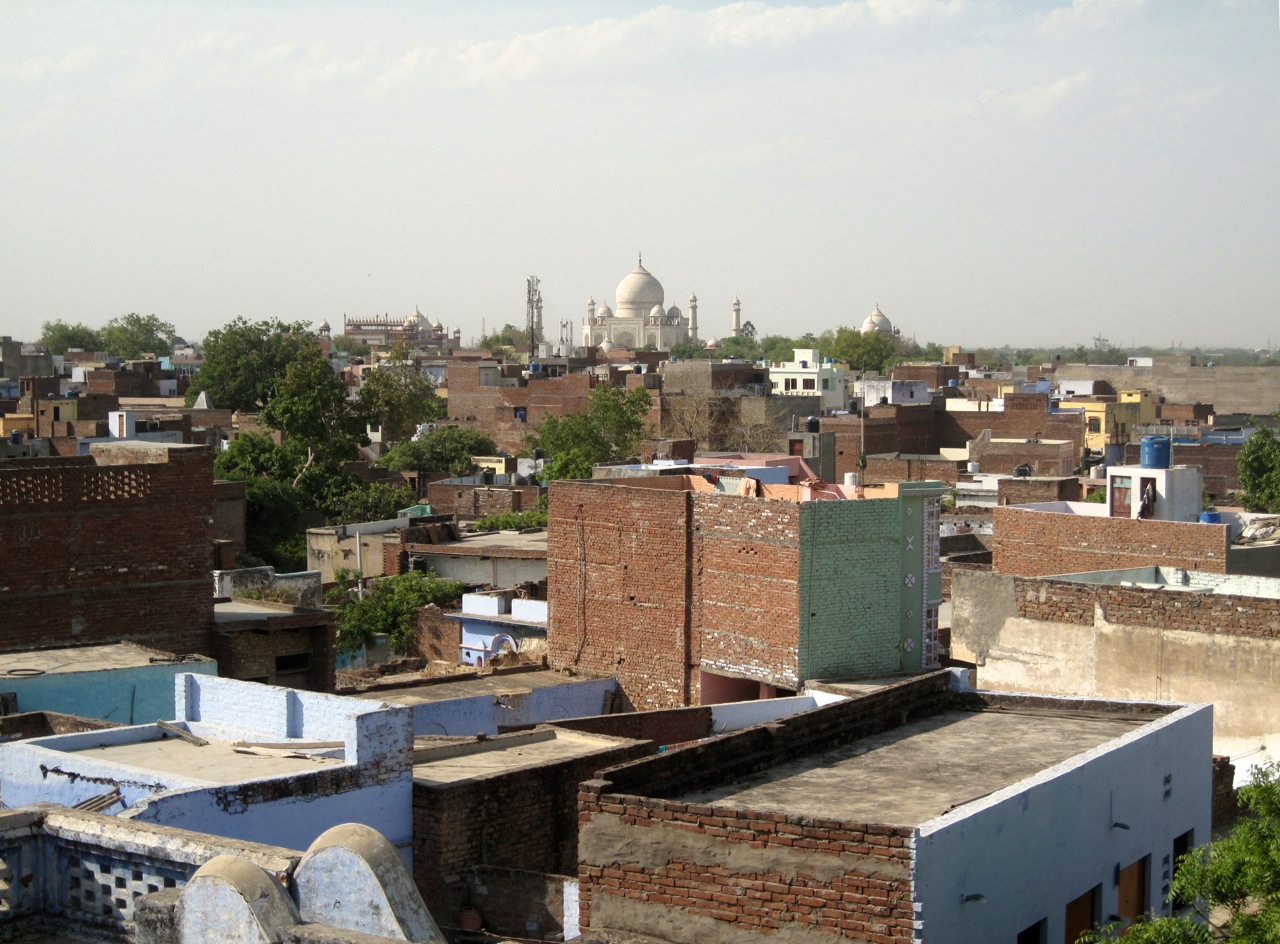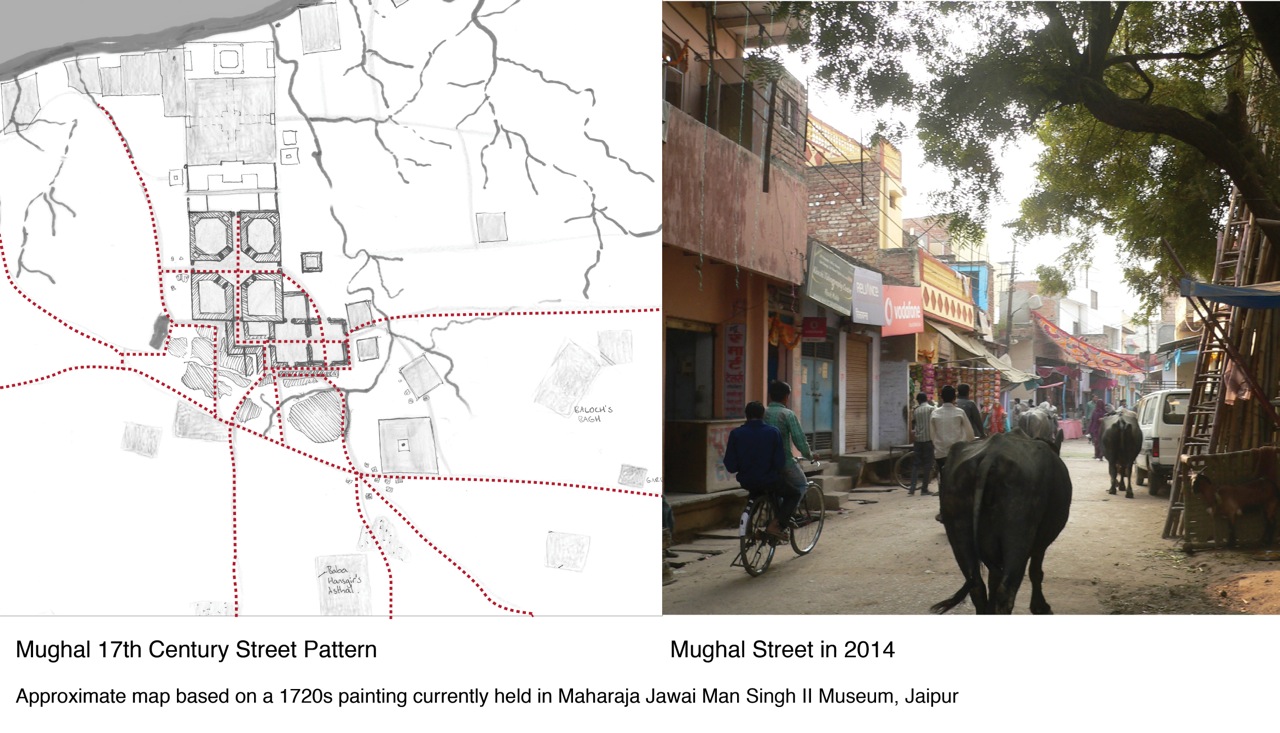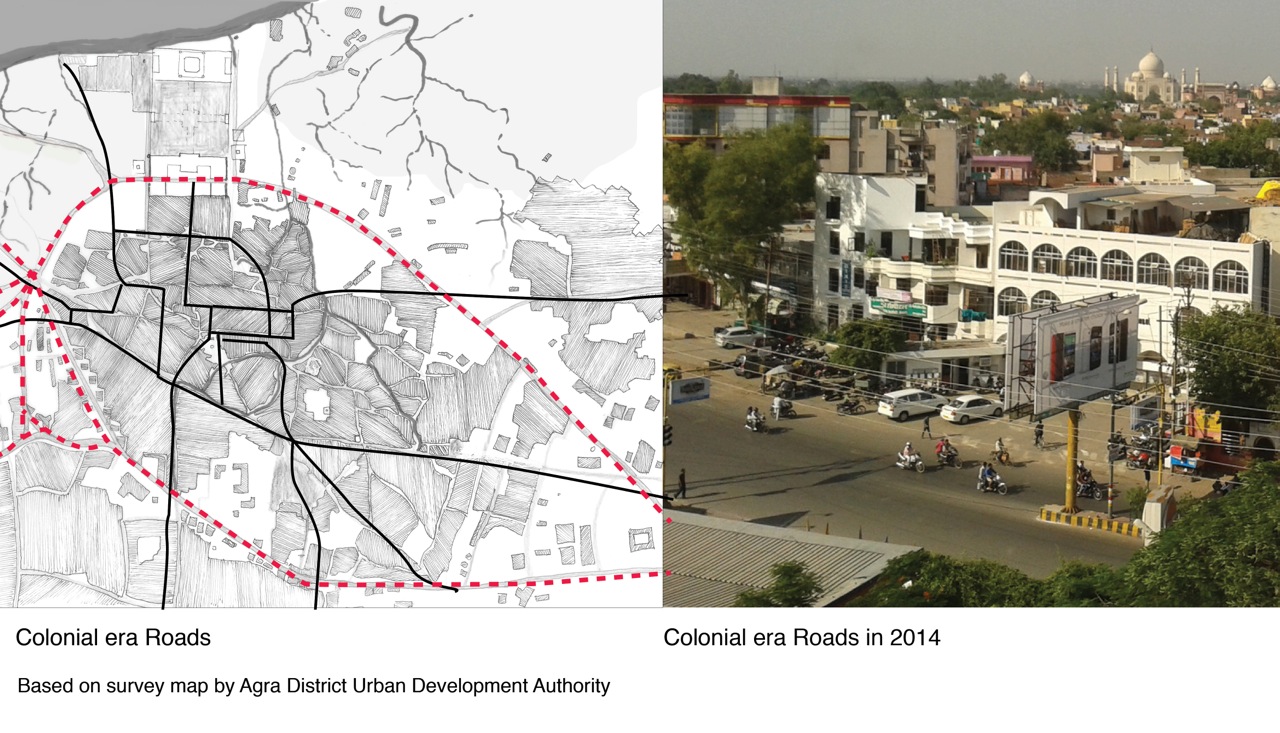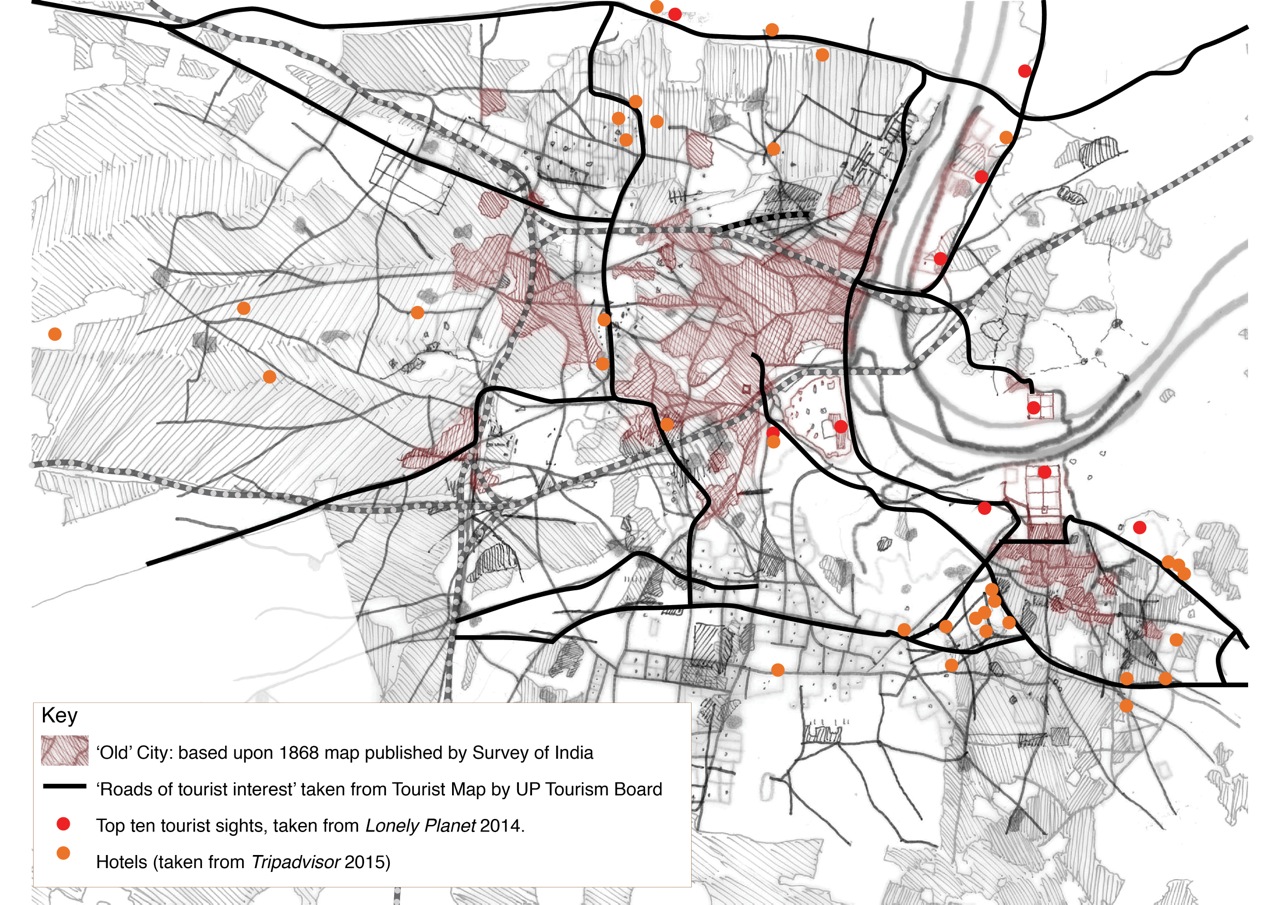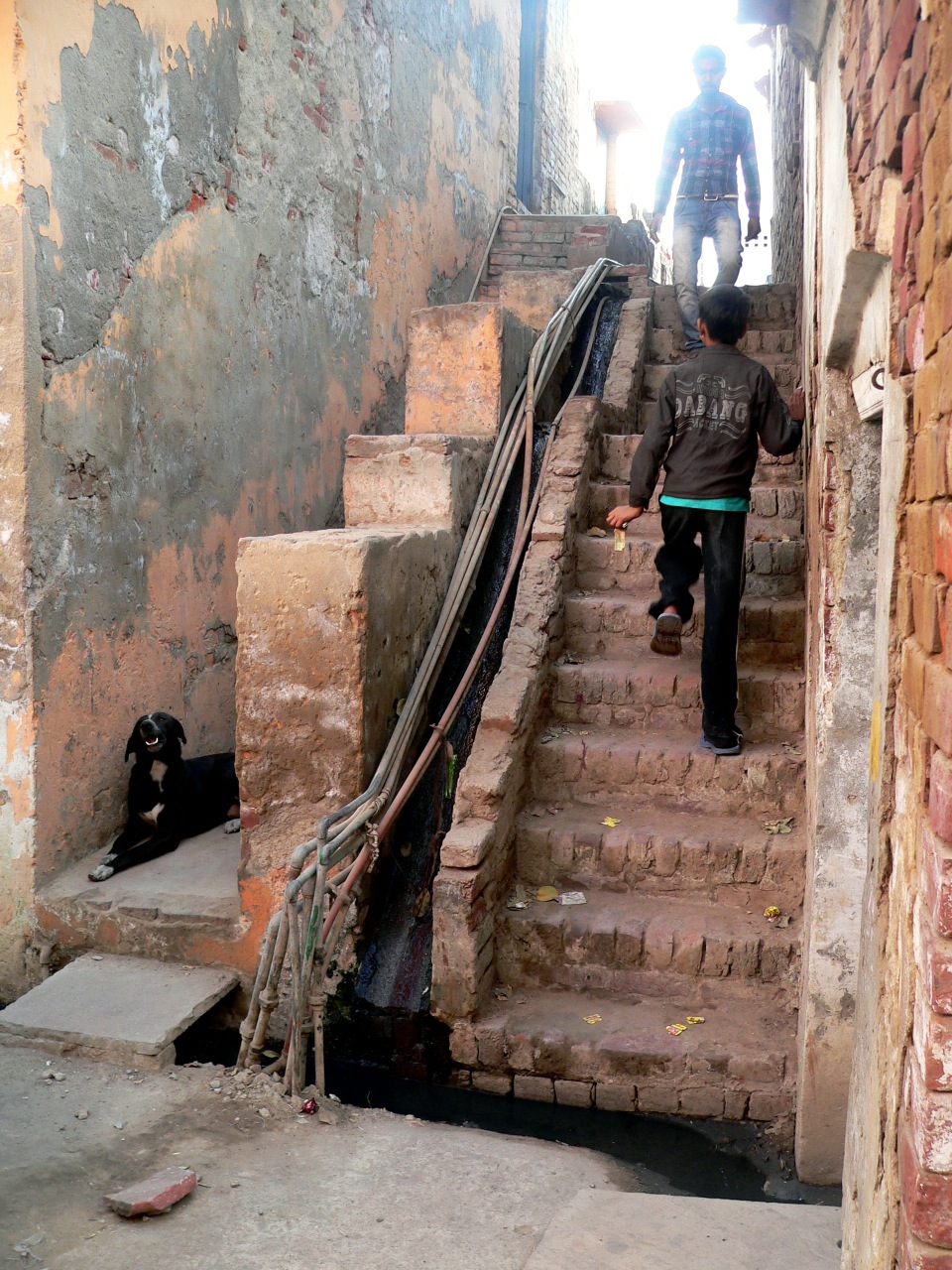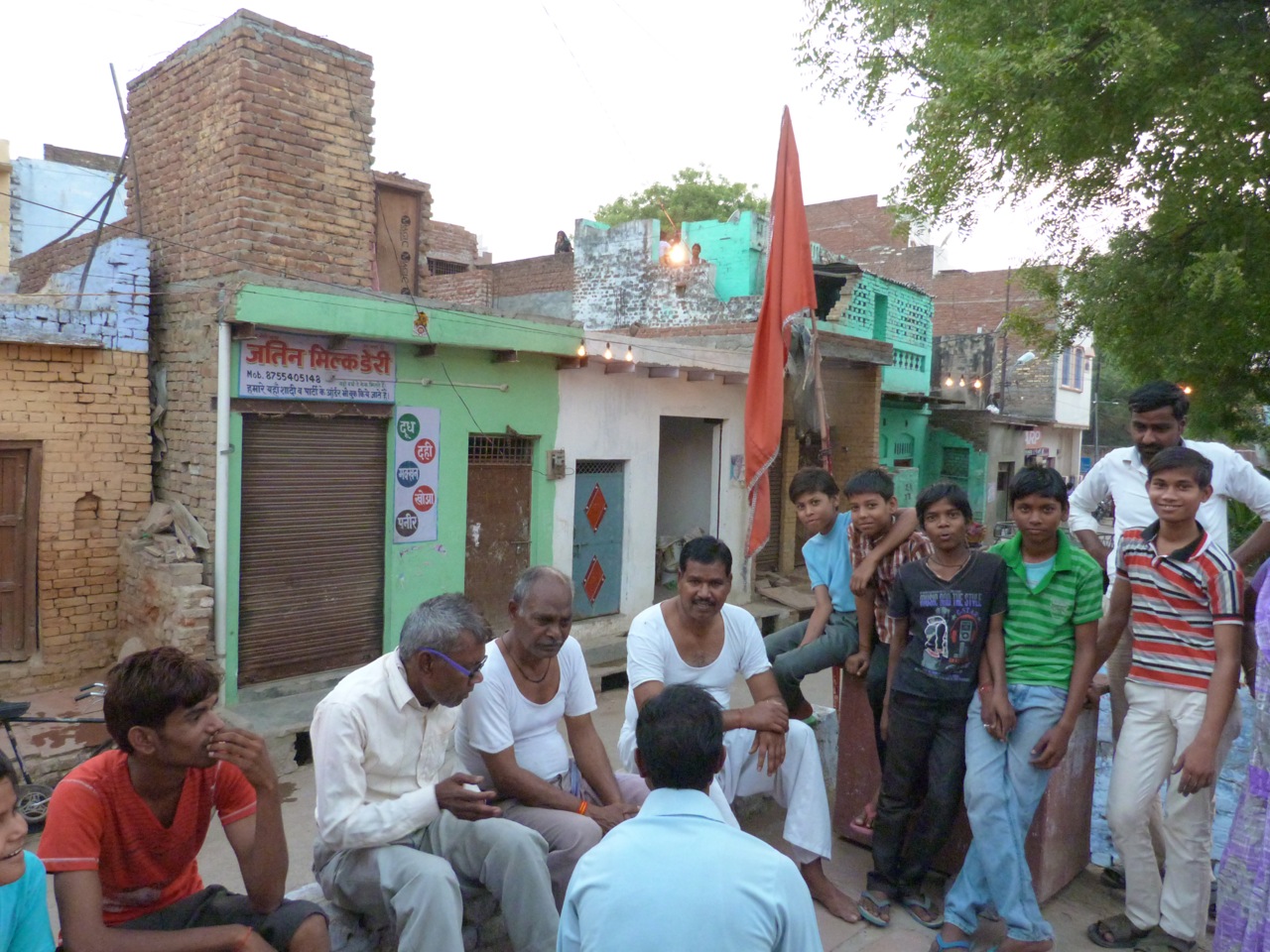Fortuity of Neglect
Tajganj, a cluster of ‘bastis’, (neighbourhoods), is a 400-year-old market district in the North Indian city of Agra: home of the Taj Mahal. As a government funded regeneration scheme in Tajganj commences, a major focus for politicians and press is the ‘protection’ of the area’s ‘cultural heritage’. However, it is hard to pin down what is meant by ‘cultural heritage’, and what it needs protecting from. The possibility that perceived dangers such as unregulated construction, or cottage industries are not outside or counter to ‘heritage’ has not been adequately explored.
Tajganj owes its unique urban condition to accidental isolation. Developing in the space between two main roads, it has until now escaped major state intervention: with mixed results. As this ‘heritage’ of autonomy is abruptly ended by the regeneration scheme, the matter of ‘what to keep’ is fraught with complication.
Man Versus ‘Monument’
Tajganj was, up to the 1940s, a wealthy area. However, in a population upheaval after Indian Independence many of its wealthier families left. Most of the land was sold in the 1980s. A subsequent population increase put strain on Tajganj’s infrastructure, and the area physically deteriorated.
The Tajganj bastis abut the Taj Mahal – India’s most visited ‘monument’. Generally outsiders have no reason to see the Tajganj interior, so impressions are based on parts of the bastis that come out into view. These are their least pleasant features. For example, a ‘naala’, (malodorous open drain), runs under the main approach road to the Taj and into the river Yamuna. Touts and beggars, (not necessarily from Tajganj), shout at passers by in the streets adjacent to the ‘monument’, giving a false sense that the Tajganj alleys behind are a pathetic, poverty-stricken scene. Tajganj’s reputation does not accurately reflect its reality.
Regulations have been put in place to stop the Tajganj area negatively impacting tourists’ Taj experience: a near-impossible planning application has to be granted before new construction is permitted within 500m of the famous tomb. Industries creating any pollutant believed to discolour the building’s white marble have been banned from the inner city. This affects the lowest paid citizens such as Tajganj’s residents disproportionately, because they are the people that work in small industry, and cannot afford architects to make planning applications, or the bribes to get around it.
The Archaeological Survey of India has selected ‘what to keep’ in the city master-plan, so individual sites have won protection as valuable ‘heritage’, ignoring the fabric in-between. There are five ‘registered’, (listed), ‘monuments’ in Tajganj excluding the Taj and its grounds. Within 300 metres of any registered monument, once again a near-impossible planning application is necessary to build or even repair a building. Thus, imposed over the intricate pattern of 17th century lanes and ‘chowks’, (squares), is a pox of blighted rings, (called ‘prohibited’ and ‘regulated zones’), containing a mix of crumbling buildings and illegal bribe-bought construction. At the centre of each ring: a ‘monument’ restored in isolation, often ticketed, gated and stripped of civic activity.
This is India: in most ‘regulated zones’ illegal constructions vastly outnumber crumbling buildings, and residents survive in the vulnerable space between ‘the law’ and what individual law enforcers consider acceptable. However, not only has ‘heritage’ planning displaced citizens undemocratically from the inner city, it has lost any relation to a conversation about what ‘heritage’ is. This is not a process underpinned by a commitment to the continuity of things people value. This is a process driven by desperation for tourist dollars, guided by a preservationist moral compass inherited from colonial rule.
How does this relate to Tajganj’s regeneration scheme? The development authorities plough on with a strategy of ‘monuments’, ‘attractions’ and their access roads. A few artefacts within the bastis have been brought into these categories because they look old or ornate. However, this is a district of 30 thousand people: the majority of the bastis’ interior, not considered to have ‘heritage value’ is simply on track to become indistinguishable from other perceived ‘developed’ residential areas in the city. However Tajganj is not like the rest of the city. It is unique.
Local Centre, Global Crust
The two 20th century roads that encircle Tajganj were constructed by the British. Before this, the ‘main road’ was a bazaar street that still runs up the middle of the bastis, arriving at the Taj Mahal. Guesthouses and market stalls once lined this bazaar. Today, internationally owned 5 star hotels, restaurants and malls encrust the edge of the British roads. These buildings are tall and impenetrable. The old bazaar street is unknown to outsiders occupying the ‘crust’, behind which the bastis have largely been left alone, shaped through informal reinterpretation and negotiation.
The area has enjoyed a high degree of autonomy because the rest of the city has not valued it. Like many cities across the globe, Agra has become a patchwork of wealthy gated communities, (locally called ‘colonies’), and un-gated low-income neighbourhoods. For centuries, it has been common for wealthier classes to move out of the congested centre towards the suburbs, meaning that the inner city is experienced by the wealthy from cars, motorbikes or auto-rickshaws. This affects the way that the city’s funds have been spent. Investment in the tourism ‘industry’ takes priority, and the tourists’ experience of the city is curated not by ‘Tajganj-ers’ or inner city inhabitants but by the wealthier city residents that enjoy positions in the municipal authority. So it is an experience reliant on vehicular transport. Funds have not been put into pedestrian routes, or areas that are accessed by foot.
The Tajganj interior is as much a mystery to those making planning decisions as it is to tourists. Even now that the regeneration scheme is underway, a handful of site visits, OS maps and reports, rather than experience, informs the development authorities, who pass the responsibility to consult with residents over to NGOs. Regeneration becomes a matter of ‘solving the slum problem’, rather than engaging with the area’s conflicts and opportunities.
The Form of Self Sufficiency
In place of state maintenance, local solutions have grown in Tajganj. A sewer line runs under the bazaar street, but most houses are not connected to it, so makeshift pipework or drainage channels cut up the road surface. A tangle of electric cables hovers above the bazaar, siphoning off supply from the main line. In lieu of adequate rubbish collection, people pile up mountains of waste in certain agreed empty plots, often inaccessible by truck. Never fully emptied, they smell and attract street dogs, rats and disease. These are the conditions that have lead to some bastis being labelled ‘slums’, and the things the regeneration scheme aims to put right.
However, the lack of city involvement runs deeper than infrastructure. Tajganj has not been adequately regulated – from building work to children’s education. Last year, charity funded health workers mapped out households, numbering and naming them in order to keep track of pregnant women and new babies, which will save innumerable lives. This is the kind of involved urban exercise that honours a city’s citizens. However, the city’s focus is not on difficult, small-scale interventions in the existing fabric. Its focus is on building new ‘attractions’ on the global ‘crust’ (a planning application has been made for a theme park).
There have however been advantages to Tajganj’s history of neglect, the first being that land behind the crust is not sought-after by outsiders. There is little consumer footfall inside, given that visitors move around the edge. This has protected the interior from the cheap souvenir stalls and international brands that dominate the crust. Instead, local street food vendors flourish along the interior streets, and with them the social structures they support. A lack of empty plots or streets wide enough for cars means a number of neighbouring houses would have to be bought and demolished in order to build the kind of apartments, (with parking), that would attract wealthier buyers. At present, most ‘Tajganjers’ would be reluctant to move, because they work in the bastis or in the inner city, so it is easier for developers to build apartment blocks in easy reach of the city along the NH2 highway. Anyway, a Tajganj address still carries an undesirable reputation for many. Given the city’s reliance on cheap labour, it would actually be problematic for ‘Agra-ites’ if Tajganj’s current residents did have to move, but this is a problem many cities are now dealing with, and no doubt Agra will eventually have to as well.
Spatial Practice: Urban ‘Heritage’?
The old bazaar street has become unbelievably local, considering that it is the road leading out of the Taj Mahal’s South Gate. More of a long, narrow plaza than a thoroughfare, it is a shaded space that people use for socialising as much as for shopping. Formal meetings take place on verandas. People sit on doorsteps and drink tea. Friends haggle with shopkeepers over second-hand electrical appliances. Here, pressed up against the boundary walls of the Oberoi or Radisson Blu, an unfamiliar face is unusual.
Turn off the bazaar street and spaces become even more familiar. In one basti, the old ‘panchayat’ building, (community hall), on the chowk stores chairs, decorations and cooking equipment. On the roof is a movable scaffold structure for a canopy. The small shop opposite keeps fairy lights, while another house stores extension cables. Within a day a wedding is set up to seat 300 using the alley, chowk and a tomb structure in a manner that can only come with practice after hundreds of weddings there. Twenty metres away, in the neighbouring basti, a tent has been set up in another chowk to mark Muharram, (Shia time of remembrance), and each group can carry out their business without interference from the other. There is an expertly flexible, and spontaneous, (if sometimes dangerous), way of using the basti space which could never happen in the transparency of ‘public’ space in the regulated, master-planned parts of Agra. Diverse values are somehow catered for in very close proximity.
Institutionalised Commitment to Place
The urban environment doesn’t cause this behaviour: architecture and occupation shape each other. Years without state interference do not just lead to weddings in streets. They lead to institutionalized self-governance and negotiation.
The world of the basti is a world of committees, and many of these are groups formed around the maintenance, adaption, and guarding of places. It is because of these committees that a wedding can go up in a day: they are an archive of place-based knowledge. However, because of their practiced agency in looking after place, their habitual get-togethers, and the respect they accumulate, they can do a lot more than organise weddings. They can join forces with other committees in order to get things done. They can assert a certain amount of democratic pressure up to the municipal corporation on behalf of their constituency to get a sewer leak fixed, the street swept, or stop people building on the graveyard. It cannot reverse the slum conditions or stigma, but it allows certain values to be upheld.
In Tajganj, institutionalised negotiation of difference is held both in the reproduction of social decision-making structures related to place, and the diversity of shared space in the physical environment. Because of this decision-making capability, the shared space can then be shaped by the people themselves to stay relevant to their values. The carefully worked out spatial diversity to peacefully house social difference is one of Tajganj’s strongest resources. Yet it goes uncelebrated, because the focus of planners is always on isolated ‘monuments’, rather than architecture’s relationship with people.
Implications
Locally identified ‘historically significant’ architecture in Tajganj is often a crucial part of the urban topography. However, it must be recognised that these pieces are just part of a bigger urban condition that is even more valuable. If any ‘heritage’ should be considered for protection, it is the spatial differentiation, along with the local decision-making capability to adjust it.
The question then, is how positive aspects of self-sufficiency, or ‘forgottenness’, can be taken forward whilst increasing outside engagement with the area: leaving the bastis alone is no longer an option. Tajganj must lose its stigma and become a cherished part of the city, or its residents will not enjoy the same opportunities as other ‘Agra-ites’, or the freedom to stay indefinitely.
The maintenance of valued places by local committees is probably threatened by changing expectations of Tajganjers if the area’s regeneration process leads to better income and reputation. If the majority of today’s middle classes are taken as precedent, it seems likely that residents’ requirement of the state, rather than themselves, to maintain their shared spaces will grow as they become financially better off, or the shared spaces will get incorporated into private enclaves.
The key could be to stop seeing regeneration as a process of simply making neglected city districts more like the developed ones. Instead, outsiders could start learning from places like Tajganj and appreciating the differences, if not borrowing some of their ideas. The more people value things like local committees as an urban ‘heritage’ worth bringing back, the more resilient that institution becomes, the more it is respected by the state. Whether the state focuses on ‘monuments’, theme parks or pathways, the most endangered ‘cultural heritage’ in Tajganj is its residents’ participation in the shaping of their urban environment.

